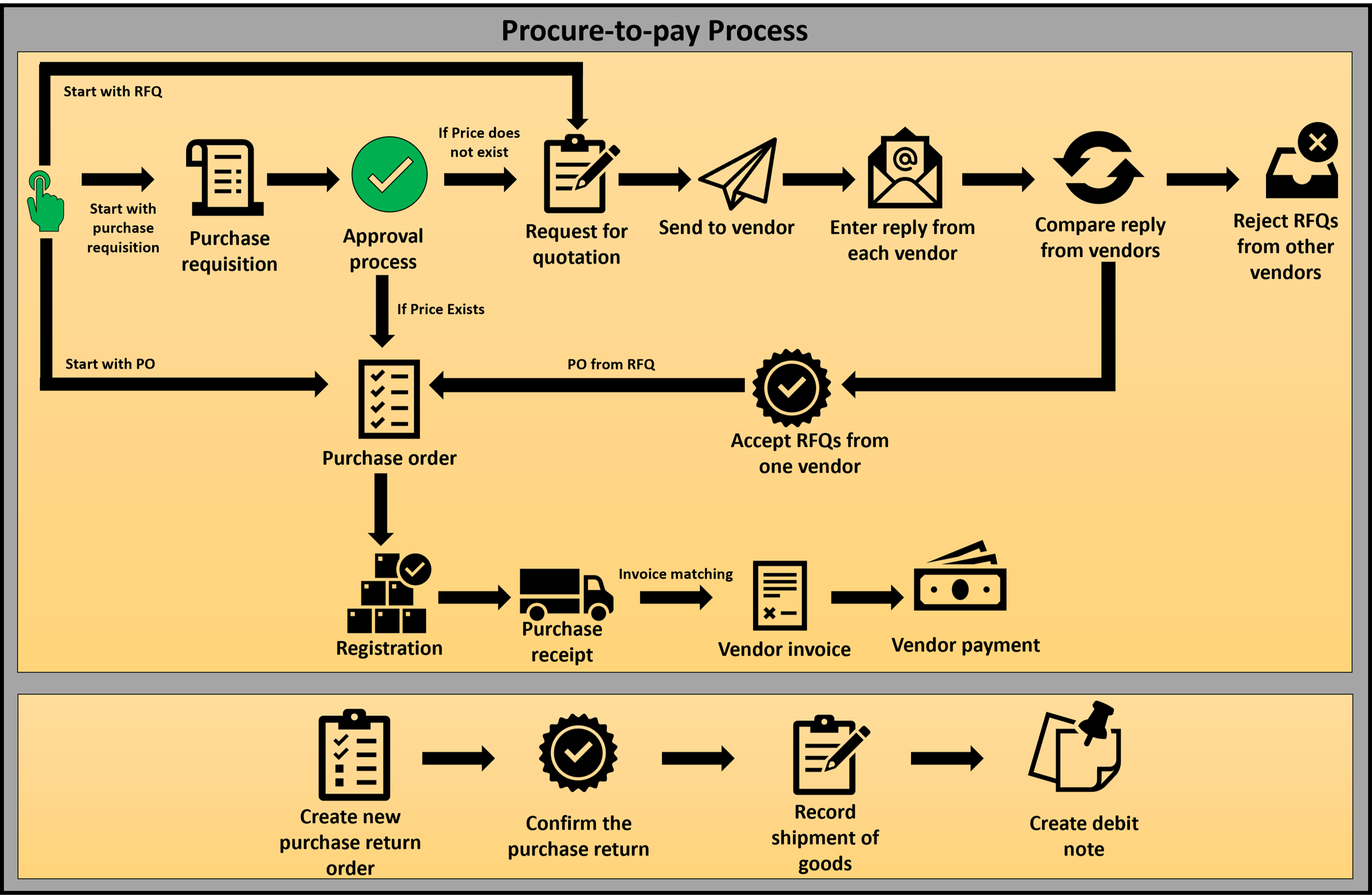Describe the procure-to-pay process
The Procurement and sourcing module in Supply Chain Management manages The procure-to-pay process. This process involves approving the purchase requisition, onboarding vendors, maintaining purchase orders, and confirming product receipts. The process ends after the processing of the purchase invoice. The following diagram illustrates the procure-to-pay process.

The major transactions in this process are as follows:
Purchase requisition
Request for quotation
Purchase order
Purchase receipt
Purchase invoice
Purchase requisition
The purchase department of your organization uses a purchase requisition as the base document to procure a product or service. In the usual process, any employee in the organization can create the purchase requisition. The purchase requisition must go through the workflow process, based on the workflow configuration defined. When approved, the purchase requisition can be referred to for further processing.
Request for quotation (RFQ)
Organizations issue RFQs when they want to receive competitive offers from vendors for the items or services they need to purchase. This process includes the quoting process, traceability, and better collaboration among vendors. In this process, vendors can provide product prices, delivery time, other incidental charges, and a discount as a part of the bid. The vendors registered for vendor collaboration can directly put the bid in the vendor portal. The organization can accept the most suitable bid and proceed for further processing.
Purchase order
A purchase order is a document that represents an agreement between a company and a vendor to buy goods or services. A purchase order can be created directly from an approved purchase requisition. You can also create a purchase order from the approved RFQ. You can create a new purchase order from the purchase order page as well.
A purchase order contains two main sections: Purchase header and Purchase lines.
A purchase header holds the PO number, date, vendor information, and other details applicable to the entire PO. Each PO can have one or more purchase lines. Purchase lines consist of item, unit of measurement, procured quantity, price, and other information related to each line. Information like discount, tax, and delivery address is available in both the header and line.
When using the Purchase order preparation workspace in Supply Chain Management, you can set up a default order type for three types of purchase orders, as described in the following table.
| Purchase Order type | Description |
|---|---|
| Journal | You can use this type to create a draft order. This type doesn't affect stock quantities or generate inventory transactions. The purchase order journal lines aren't included in master scheduling. |
| Purchase order | You can use this type to create purchase orders when orders are confirmed with a vendor, are processed through receipt, and invoicing before payment is made to the vendor. This type of purchase order is the most common. |
| Returned order (also RTV, Return to vendor) | You can use this type when you return goods to the vendor. This type of order requires that you specify the return material authorization (RMA) number that the vendor provides. You specify the RMA number on the General tab of the purchase order. The order lines must have negative quantities. |
Purchase orders include the following status fields that indicate the progress of an order: open, received, invoiced, and canceled.
Purchase receipt
Product receipt involves documenting the reception of ordered items. When products are preregistered, you need to complete other procedures before acknowledging the receipt of these products. The registration process ensures the storage and tracking dimension of the product before processing the receipt. In the usual scenario, the product is received when the Product receipt option is processed after the registration process is complete. In some situations, the products might go through other processes, such as quality management, before they're finally marked as Received.
Purchase invoice
When you review a purchase order, you can process the purchase lines for invoicing. Invoicing a purchase order increases the open vendor balance and also increases the financial value of the inventory. It posts the transaction to the appropriate ledger book. Before you post the invoice, it must go through the invoice matching process to ensure consistency among vendor invoice, purchase order, and product receipt information.
Purchase return
You create a return purchase order when you need to return items that you purchased from a vendor. You can create a purchase return by using the Credit note action. You can use this action to copy lines from a vendor invoice document and create a new PO for return. The PO for return includes the confirmation process that you follow for a regular purchase order. You can process a shipment for the purchase return to send the items back to the vendor.